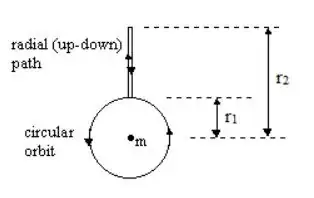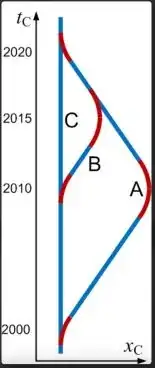Sabine is not just wrong. She is spectacularly wrong.
Here are 5 counterexamples of Sabine's claim that time dilation and differential ageing are caused by proper acceleration.
Counterexample 4 involves neither gravity nor circular motion. Only linear motion in flat spacetime is involved, and this is the final nail in the coffin of the "acceleration causes time dilation" argument.
Counterexample 1:

This example comes from Mathpages. One projectile goes straight up, reaches apogee and falls back down to the starting point, while another projectile orbits the gravitational body. Neither projectile is under power. Both projectiles are free-falling during the experiment, so neither projectile experiences proper acceleration, but they experience different elapsed proper times. There is no proper acceleration anywhere in this experiment to explain the differential ageing, falsifying Sabine's claim.
Counterexample 2:
One rocket hovers above a black hole using thrust to remain stationary at a Schwarzschild radius greater than $3GM/c^2$. Another rocket orbits with its engines off. They both experience the same gravitational time dilation due to having equal altitude, but the orbiting rocket experiences additional time dilation due to its orbital velocity. In this case, the orbiting rocket is in free fall, so it experiences no proper acceleration, while the hovering rocket does experience proper acceleration due to the thrust required to keep it stationary. In this case, the rocket with proper acceleration experiences less time dilation than the rocket in free fall, in direct contradiction to Sabine's claims.
Counterexample 3:
When particles are put in a centrifuge and spun up to high angular velocities, they experience extreme proper acceleration, yet all the time dilation (as measured in changes in half-life) is due to only the tangential speed, not the acceleration. This "... has been verified experimentally up to extraordinarily high accelerations, as much as $10^{18g}$ in fact. See the Clock Postulate. by Baez.
Real experiments carried out by scientists confirm that acceleration has no effect on the half-life of radioactive elements, in direct contradiction to Sabine's claims.
Counterexample 4:
A slightly modified Twin paradox. Consider the diagram below, created by DrGreg of Physicsforums.

In this spacetime diagram (time up, space across), twin $\text{A}$ accelerates away from Earth and returns as in the usual Twin paradox. Twin $\text{B}$ also accelerates away from the Earth but turns around sooner, returns to Earth and waits. Both twins experience exactly the same proper acceleration for exactly the same durations. The slower ageing of twin $\text{A}$, which travels the furthest in the Earth frame, can not be attributed to a difference in proper acceleration, in direct contradiction to Sabine's claims.
Counterexample 5:
Consider two rockets following circular paths in space.
The path of rocket $\text{A}$ has a radius of $1 \ \text{light-year}$ and has a tangential velocity of $0.4c$.
Rocket $\text{B}$'s path has a radius of $16 \ \text{light-year}$ and a tangential velocity of $0.8c$.
When their locations coincide, that is the start of the experiment. After rocket $\text{B}$ has completed one revolution, it is back at the start and rocket $\text{A}$ is also simultaneously back at the start but has completed $8$ revolutions.
The relativistic equation for centripetal acceleration using units such that $c=1$ is $a = v^2/r \sqrt{1-v^2}$, where $v$ is the tangential speed as measured by an inertial observer that remains stationary at the mutual starting coordinate. The proper centripetal acceleration, as measured by the rocket pilots, is simply $a' = v^2/r$, the same as the Newtonian expectation. Rocket $\text{A}$, following the smaller circular path, experiences a proper centripetal acceleration (as measured by an onboard accelerometer) of $v^2/r = 0.4^2/1 = 0.16 \ \text{ls/s}^2$ while rocket $\text{B}$ with the greater velocity following the larger circular path experiences a proper acceleration of $v^2/R = 0.8^2/16 = 0.04 \ \text{ls/s}^2$.
Rocket $\text{B}$ experiences less proper acceleration but experiences greater time dilation, in direct contradiction to Sabine's claims.

